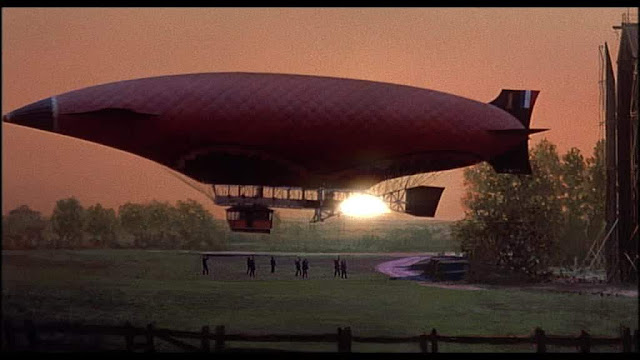There was also a smaller Hyperion built pictured below.
The model supervisor was Terry Saunders.
A lot of the airship shots in the film used photo cutouts of the model pasted onto glass and moved against a a background, either a painting, live action shot or a combination of both. These shots are usually long shots and where the perspective doesn't need to change on the model. In Some shots the angle of the still photo of the Hyperion does not quite match the angle of its motion relative to the background so it appears to slide sideways somewhat. Often a foreground layer of mist and cloud was painted on another sheet of glass and moved at a slightly different rate.
The miniature shots were photographed by Art Cruikshank and they work pretty well. The model was attached to a rig on the end of a boom by wires which enabled yaw and pitch motion.
 |
| Small Model on its boom rig. Note bicycle wheel for yaw axis. |
A couple of large miniature environments were constructed, one of the
iceberg strewn ocean and the other a snow capped mountain range where
the Hyperion comes to grief.

There are also some pretty impressive animatronic killer whales that appear both in full size for interaction with the actors and in miniature form for some leaping out of the water long shots.
The visual effects supervisor and art director was Peter Ellenshaw and there is a massive amount of matte painting work throughout the film. There is a pretty scholarly and detailed account of the matte art for this film on NZ Pete's MatteShot blog which I thoroughly recommend reading.
 |
| Airship photograph blow up mounted on glass. |
 |
| Photograph on glass again for this shot. |
 |
| The model here as it changes angle through the shot. |






























































































































































No comments:
Post a Comment